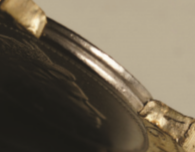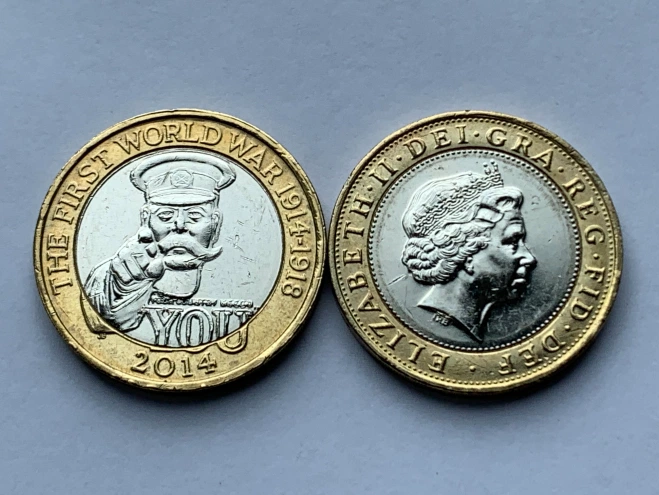Posts Tagged ‘striking error’
Have I found a rare coin? £2 ‘errors’ explained!
So you’ve noticed something’s not quite right with the £2 coin you’ve just found in your change. A quick web search of the strange variation you’ve noticed shows a plethora of eBay listings and news articles claiming that you might have just hit the jackpot and your ‘error’ coin is worth a small fortune! But before you think about selling your coin, you should first find out a bit more about how these errors occur.
Read on to learn more about some of the mis-strikes found on £2 coins and how their bi-metallic quality causes the differences to be something entirely more spectacular than those found on monometallic (single metal) coins.
Striking bi-metallic coins
In order to understand why mis-strikes on bi-metallic coins are often more pronounced than monometallic coins, it’s first a good idea to look into how these coins are produced.
When striking £2 coins, the first step is to punch a hole through a blank planchet to create the outer section. The inner core is taken from a different metal, sized to fit inside the outer ring.

A groove is milled around the edge of the inner core so that when both parts are struck together, the metals will fuse as the outer ring deforms and spread into the groove, locking it into place.
Now that we know how £2 coins are struck, here are some of the mis-strikes and errors that can occur in the process…
Clipped Planchet

Image Credit: Coin News
This first example shows how the inner core was punched out from the end of the sheet of metal used for blanks, forming a straight or ragged edge clip.
Whilst this also occurs with monometallic coins, the pairing with an outer ring exposes a large gap which is much more noticeable.
The Royal Mint strike millions of coins each year, so it’s inevitable that variances will occur during the striking process and can’t always be picked up during quality control, despite the fact that this particular coin would weigh less than the standard 12g £2 coin. However, a small quantity of coins do sometimes manage to slip through the net and as I’m sure you’ll agree, they make for interesting collecting.
But before you pay over the odds for one of these coins, beware of fakers! Some coins are manipulated to look like mis-strikes or error coins and sold to unsuspecting buyers. Check the clipped planchet edge of the coin to see if it’s genuine by making sure the detail of the design fades away towards the edge rather than suddenly stopping, which would indicate the coin had been cut.

Off Centre Inner Core

Image Credit: Coin News
This image shows an inner core which hasn’t been aligned properly prior to being struck.
Due to the way the inner and outer core are struck together with the two metals being lined up and then fused together during striking, a misalignment will mean that the inner core spills into the outer ring, as seen in the image above. There might also be a gap between the two metals on the opposing join.
This mis-strike is thought to be fairly common on the bi-metallic 12 sided £1 coin as well as some of the Technology £2 coins and even foreign bimetallic coins, but have you ever spotted one in your change?
Faulty Outer Ring

Our next example shows a faulty planchet or outer ring, where the inner core is exposed.
In the image above, you can actually see the specific engineering design where the inner core is grooved to help the metal bond to the outer ring and fuse during striking.
Similar to the first mis-strike we looked at, this could be caused by a clipped planchet, this time created when the outer ring was punched, however coins like this may also be caused by tampering post striking, for example by fakers trying to replace the inner core of a £2 with another coin to pass off as a rare error.
The Holy Grail of Bi-metallic ‘Errors’

Image Credit: Coin News
This type of error is described as the Holy Grail of bimetallic ‘errors’ and is the result of the nickel-brass £2 blank not having the inner core section punched out before being struck.
This means that the £2 coin is made from one full piece of nickel-brass, completely contrasting the very notion of a bimetallic coin.
A 2007 monometallic £2 was verified by The Royal Mint and in the email confirming the mis-strike, it was mentioned that they had only seen 4-5 similar coins before.
This rare striking error is highly sought after and coins have achieved extraordinary prices in private sales and auctions.
Foreign Planchet

Image Credit: Coin News
Another £2 error that can occur is when it’s been struck on the wrong planchet – a blank normally used to strike a different coin.
As The Royal Mint strikes a huge quantity of coins for different denominations and even different countries, blanks can sometimes end up in the wrong striking chamber, creating a wrong or foreign planchet error.
This is actually down to human error rather than a mis-strike and the coins would normally be picked out during quality control, however some have been spotted in circulation, not only on the £2 coin, but on various different denominations across UK coins and world wide.
Other £2 ‘errors’ that are worth keeping your eyes peeled for!
2014 First World War Kitchener £2 – Missing denomination
This £2 coin was issued in 2014 to mark 100 years since the outbreak of the First World War. It features an image of Lord Kitchener who was a prominent figure on British government propaganda campaigns during the time.

5,720,000 of these coins entered circulation, meaning it could be quite easy to stumble across one in your change. However, a small number of these coins are supposed to have entered circulation without the ‘Two Pounds’ denomination on the obverse.
Sometimes the denomination of the coin will feature on the reverse design, meaning it won’t appear on the obverse too. This can be seen on the Trinity House £2 coin which was issued earlier in the same year as the First World War £2.
It’s possible that the dies used to strike the obverse of the Trinity House £2 coin wasn’t replaced when the production of the First World War Centenary £2 coins began, resulting in the absence of a denomination.
We’ve only heard of two reports of these ‘error’ coins being found in circulation. However, Lockdales Auctioneers officiated the sale of the very first one back in March 2020 to the value of £500!
2015 First World War Navy £2 – ‘Flag’ error
When it was issued in 2015, the First World War Navy £2 coin caused a stir in the collecting world as it was revealed to be one of the rarest £2 coins, with just 650,000 struck for circulation.

The original Navy £2 design (above) shows the coin without any markings on the top right of the mast, but some eagle eyed collectors noticed that their £2 looked to have a flying flag.

As you can see from the two coins pictured above, the coin on the right looks like it has a flag atop the mast, whereas the first coin is free from any markings.
A number of people enquired about whether there were two different designs of the Navy £2 coin struck for circulation, however it was confirmed that the addition of the ‘flag’ was not intentional, and most likely caused by a cracked die.
So how much is my ‘error’ coin worth?
Whilst genuine error coins are out there and can be valuable, so too are a number of common mis-strikes and myths, or even fakes that have been manipulated to look like an error.
These coins certainly make for interesting collecting and the rarer variations, such as monometallic £2 coins could certainly sell for way over face value.
In fact, one such monometallic mis-strike found on a 2007 Technology £2 is estimated to be worth over £1,000!
Ultimately, as with all coins, it’s all down to how much an individual collector is willing to pay to add that coin to their collection, so we recommend checking out our 6 Point Guide to valuing your coins to determine it’s worth.
If you’ve found a £2 coin with a mis-strike, it’s also worth having it verified and authenticated by The Royal Mint, who will supply a letter detailing their findings.
So have you found any interesting variations on your bimetallic £2 coins? Let us know in the comments below!
With thanks to Scott Wren from Coin News.
Find out more about your coins
If you’re interested in coin collecting, our Change Checker web app is completely free to use!

Is there an even rarer version of the Navy £2 in circulation?
Change Checkers have been speculating whether there are two different design variations of the 2015 Navy £2 coin that was released into circulation a couple of months ago.
This coin has already caused a stir in the collecting world as we revealed it was one of the rarest £2 coins with just 650,000 struck for circulation.

The 2015 Navy £2 coin was released into circulation a couple of months ago.
The original Navy £2 design (above) shows the coin without any markings on the top right of the mast, but we’ve seen a few £2’s out there that look like they have a flying flag.

A number of people have been enquiring about whether there were two different designs of the Navy £2 coin struck for circulation.
As you can see from the two coins pictured above, the coin on the right looks like it has a flying flag on the mast whereas the first coin is free from any markings.
So are there two different designs?
No – The Royal Mint strike up to 5 billion coins a year and from time to time cracks in the die can cause pools of metal to form on the coin.
It just so happens that this bit of metal has caused the markings on these coins to look like a flying flag on the ship fueling speculation that two different variations were struck.
Well done to the eagle-eyed change checkers out there who spotted differences between the coins. It’s the little details like these that make collecting so interesting so remember to always check your change carefully.
Have you checked your Navy £2?
Let us know via Facebook, Twitter or leave us a comment below.
